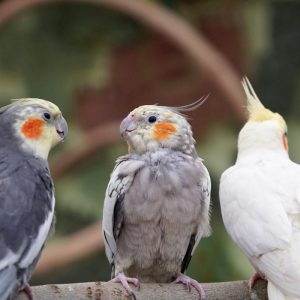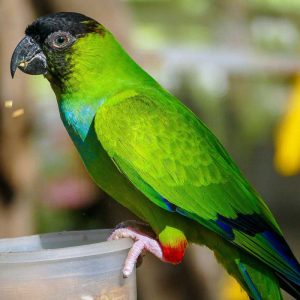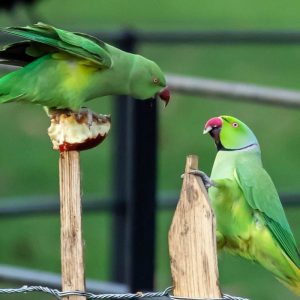Birds can be addictive. Most people cannot have just one! And if they do, it often does not last for long. You want the best for your birds, and for most that means eating a pellets or Nutri-Berries diet instead of seeds. If you share your life with multiple feathered friends and want to convert your parrots to a healthy diet, different challenges and advantages arise.
Make Flock Mentality Work For You

One of the benefits to having multiple birds is that they begin to act like a flock. Flock-like behaviors dictate that the birds within the group will do things around similar times, even if the birds do not necessarily get along. This means feeding time, social hour, and grooming activities often occur among members simultaneously. This behavior evolved in birds because, as prey species, there is strength in numbers. It is more difficult for a predator to pick out one individual in a group if everyone is doing the same thing.
Use this flock mentality when it comes to feeding time and converting birds to a better diet. First, birds like to eat at certain times of day. Early morning is one of the most common periods birds like to get together to do this behavior. Use this to your advantage. Offer the diet that you want your birds to be converted to as the first option of the day.
When a new, healthy diet is offered in the morning, it’s likely that the birds won’t know what to do with it. They may be reluctant to dig in. In a group there are usually some bold individuals and others that are shy. The more adventurous birds will likely investigate the new diet first. When those bold birds explore the new diet and start to consume it, their shy flock mates observe the activity. As they see the food safely consumed without any problems, they will likely become curious and try the new diet. Before you know it, flock mentality takes over. The birds convert quickly to a new diet.
Avoid These Feeding Pitfalls

One problem that some people encounter when they have multi-bird households is adding more food than necessary to a shared cage, just in case one bird has a more voracious appetite than another. But overfeeding frequently occurs as a result. A bird that is offered more food in a day than it needs may not select the healthiest food available. This makes the bird more reluctant to convert to a healthier diet. Compare this to a person at a buffet. When a cornucopia of food is provided, it allows for selection of what our taste buds tell us we want. The same problem happens with birds offered too much food. They select what they really enjoy, and leave behind foods they don’t favor. Often, new diets are suspicious to birds and are avoided in favor of familiar items.
In order to avoid this pitfall, only feed the amount of food that is needed for a 24-hour time period. This amount of food varies from one multi-bird flock to the next. Consult with your avian veterinarian to find out exactly how much food everyone in your flock needs. Then, offer only this amount of food daily in the cage and no more.
As a dietary conversion is taking place, mix the old and new diets together so the parrots have some of the familiar diet with the unfamiliar diet. The birds will likely eat the familiar diet first. After this is consumed, they will only have the new diet left. As the day goes on and they get hungry, the new diet will likely be consumed because it is the only option available.
Beware Of Bird Bullies

If you encounter a “bird bully” that pushes others away to get to the food, then feed the birds in separate cages. You can still take advantage of the flock mentality though. Simply place the cages nearby so that the birds can see what others are doing and be influenced by each other’s behaviors. This way, shy birds are never pushed away from the food. After feeding a meal, the birds can go back together.
If food is left in the cage though, offer only the new diet that you are converting the birds to so that should a parrot pick through the food later in the day, the option is limited to the new diet. If you choose to meal feed (offer food at specific, limited times) instead of free-feed your birds, recognize they will need a few meals a day. The frequency and amount of feeding varies for the bird species that you have.
Make Eating Fun!
Additionally, as recommended for single-bird households when converting to a healthier diet, owners can try other tricks like hiding food in toys for the birds to explore together, or placing new foods around play stands or activity centers. Convert feeding time into playtime by stuffing foraging items full of whatever food you are trying to get your parrots to explore. As one bird starts to play and investigate, the others will likely want to try it out, too!
Getting birds converted to a healthy diet is important whether it is a single bird or a multi-bird home. Use flock mentality to your advantage to substantially improve the conversion process.
